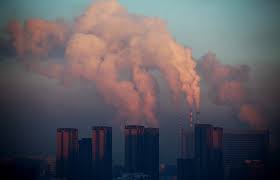A new U.N. report detailing what the world needs to do to combat climate change has highlighted the need for China – by far the world’s biggest greenhouse gas emitter – to accelerate its shift towards clean and low-carbon energy.
This week’s report by the Intergovernmental Panel on Climate Change (IPCC) said global emissions needed to peak by 2025 and fall 43 percent below 2010 levels by the end of the decade if temperature rises are to be kept below 1.5 degrees Celsius.
It also recommended a 65 percent-95 percent cut in coal consumption by 2050 and further cuts in oil and gas, putting China’s efforts to decarbonize its coal-heavy energy system–and its renewed emphasis on energy security–under the spotlight.
Frank Jotzo, economist at the Australia National University (ANU) and one of the authors of the IPCC report, told a briefing this week that China was one of several countries currently falling short when it comes to meeting global goals aimed at curbing temperature rises.
“The opportunity is there,” he said, “but the short-term actions overall and the near-term pledges that have been made are incompatible.”
China, which produces about a third of global annual emissions, has not officially responded to the IPCC report, and media coverage has been scant. Chinese researchers who helped draft the report also declined to comment.
Beijing has already pledged to bring greenhouse gases to a peak “before 2030” and achieve carbon neutrality by 2060.
But its recent focus has shifted towards energy security, following disruptive power cuts as well as the geopolitical uncertainties brought about by Russia’s invasion of Ukraine, which has also prompted countries like Germany to reconsider coal as a replacement for Russian natural gas.
Economic stability has also been a growing concern, especially as the ongoing battle against new COVID-19 outbreaks stifles businesses and disrupts supply chains.
Recent policy documents show China remains committed to coal as an energy source, at least in the short-term, with plans to start reducing consumption after 2025.
“The language at the moment is for coal-fired power generation, and more accepting of it,” said Jorrit Gosens, an ANU researcher on Chinese energy policies.
In its latest energy five-year plan, China said “advanced coal technologies” would help the transition to green energy, with coal-fired electricity providing baseline power for renewable energy bases across the country.
“They are saying it is necessary in order to allow growth in renewable energy,” said Gosens.
Another 33 gigawatts (GW) of coal-fired power capacity went into construction last year, and researchers estimate it could rise by 150 GW by 2025.
China has pledged to raise wind and solar capacity to 1,200 gigawatts by 2030, but many think it could easily build more.
Peter Newman, another author involved in the IPCC report, acknowledged that China had made big contributions to decarbonization, driving down manufacturing costs for wind and solar, and working quickly to electrify transportation, but it had to show more ambition.
“That is a sign of how commitment can occur, but it needs to extend right through China’s economy,” said Newman, who is from Australia’s Curtin University.

 Iran Energy News Oil, Gas, Petrochemical and Energy Field Specialized Channel
Iran Energy News Oil, Gas, Petrochemical and Energy Field Specialized Channel



